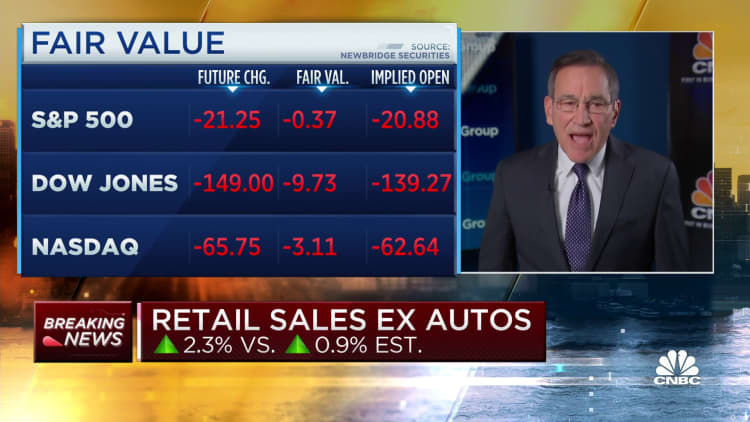
Sales at retailers rose far more than expected in January as consumers persevered despite rising inflation pressures.
Advance retail sales for the month increased 3%, compared with expectations for a rise of 1.9%, the Commerce Department reported Wednesday. Excluding autos, sales rose 2.3%, according to the report, which is not adjusted for inflation. The ex-autos estimate was for a gain of 0.9%.
Food services and drinking places surged 7.2% to lead all major categories. Motor vehicle and parts dealers increased 5.9%,while furniture and home furnishing stores saw a rise of 4.4%.
Even with a 2.4% increase in gas prices, receipts at service stations were flat. Online retailers saw an rise of 1.3%, while electronics and appliances stores increased 3.5%.
No categories saw a decline, following a December in which sales fell 1.1%.
On a year-over-year basis, retail sales increased 6.4%, which was exactly in line with the consumer price index move reported Tuesday.
Markets moved lower after the news, with major indexes slightly lower in morning trade.
Other economic news Wednesday showed that industrial production was flat in January, compared to the estimate for a 0.4% gain, according to Fed data.
While manufacturing input rose 1% and mining production increased 2%, utilities declined 9.9%, likely owing to an unseasonably warm beginning to the year. Also, capacity utilization declined 0.1 percentage point to 78.3%, below the 79% estimate.
"The monthly reports on industrial production, retail sales, and jobs were generally better than expected and point to a pickup in economic activity in early 2023 after a soft patch in late 2022. The Fed will read recent activity reports as supporting plans for additional interest rate increases in the first half of this year," said Bill Adams, chief economist for Comerica Bank.
Inflation as gauged by the consumer price index accelerated by 0.5% in the first month of the year, the Labor Department announced Tuesday. The sales report indicates that even with elevated inflation pressures, consumers continued to spend.
The data comes as the Federal Reserve is grappling with rising prices that appear to be abating, but are still well ahead of the central bank's 2% annual target.

Several Fed officials spoke Tuesday, each indicating that while they see some progress being made, there is still more work to do.
"I am confident that the gears of monetary policy will continue to move in a way that will bring inflation down to 2%. We will stay the course until our job is done," New York Fed President John Williams said.
Markets currently expect the Fed to approve quarter percentage point interest rate hikes at each of its next two meetings, then pause to assess the impact that the monetary policy moves have had on inflation, the labor market and broader economic growth.
Consumer spending makes up about two-thirds of all economic activity in the U.S. Fed rate increases are aimed at reducing demand as supply tries to catch up and to hit rate-sensitive sectors such as housing, which saw a boom during the Covid pandemic.
There's evidence that the increases are having an impact, though inflation remains persistent and could be aggravated by the economic reopening in China and rebounding growth across Europe.


